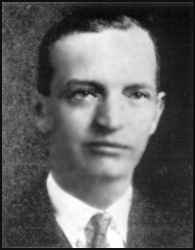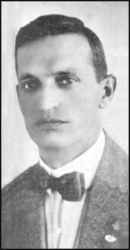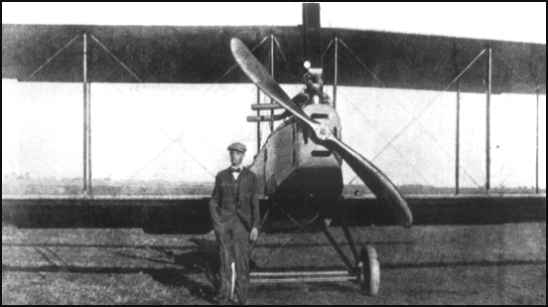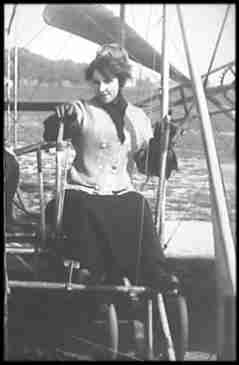

1884-1955 |
 |
 |
|
from Baling Wire, Chewing Gum and Guts by Bill Rhode Editor's note: I obtained this photo from my copy of the book. I am told that the author, Bill Rhode, died recently. I wasn't able to contact the Kennikat Press. The book is out of print, but you may be able to find a few used books online. |
from WHO'S WHO IN AMERICAN AERONAUTICS, 1925 |
|
by James A. Aubey CHARLES DAY "Born in Salamanca NY, Dec 29, 1884. Died in Pacific Palisades CA, May 26, 1955. "Charles Healy Day built his first aircraft in 1909, working with Glenn L Martin. Day is credited with developing the technique of using laminated wood to make propellers, thus increasing their strength. In 1910 he built and flew the nation's first tractor biplane, an aircraft of his own design. He worked off and on with Martin until 1915, when he was made vice-president and chief design engineer of the Sloane Airplane Company, soon to become the Standard Aircraft Corporation. There he designed and built several aircraft leading to the famous Standard J-1 used extensively for pilot training in World War I, flying the mail, and for barnstorming in the 1920s. The J-1's large forward cockpit held two passengers to double the pilot's revenue per flight. It was also the aircraft used by Otto Timm in 1922 to give a young Charles Lindbergh his first taste of flying. "In the early 1920s, Day worked as an aviation consultant, and for a short time with Elektron Metals Corporation of America, developing and promoting the use of magnesium alloys in the US aircraft industry. For two years he was a consultant on light metals to the German Chemical Trust, then in 1926 he teamed up with Ivan Gates, of the Famous Gates Flying Circus, to form the Gates-Day Aircraft Company in Paterson NJ, reorganized in 1928 as the New Standard Aircraft Corporation. During that time, Day designed his most famous and enduring aircraft, the GD-24, which evolved into the D-25 and many variants, all of which had a huge front cockpit capable of carrying up to five passengers or a big load of bootleg whiskey. Needless to say, it became a mainstay of barnstormers and smugglers. The last variant of the design was built in 1942 by White Aircraft Corporation for the Department of Agriculture, and a few are still flying today. "In 1931 Day resigned his position as president of Standard Aircraft, built a small open-cockpit trainer he called the Day Model A and with his wife, Gladys, flew it around the world - excepting oceans, where it went more logically by boat. Then in 1934, after a couple of years of consulting, he accepted an offer from Chiang Kai-Shek, head of the Canton Government in China, to organize and operate an aircraft factory at Shiuchow. He got the factory up and operating in minimum time, but by 1937 it was being targeted by Japanese bombers. To defend against the bombings, Day moved his manufacturing equipment into bamboo sheds, scattered several miles into the forest. Operating under those primitive conditions, he was able to continue production of the Fushin trainer, Curtiss Hawks under license, and Russian I-15 pursuits. Practically all of the 400 employees of that factory had no previous experience with aircraft and had to be trained by Day and his staff. "In 1940, after many harrowing experiences, the factory was cut off from supplies needed to continue operation, and the Days left China. Back in New York, he was a recognized aircraft production expert. That, coupled with his recent experiences in China, put him in great demand for the lecture circuit. He wrote articles and made several speeches on the Japanese Air capabilities. Late in 1940, he became Supervisor of Aircraft Production, Department of Munitions and Supply, Ottawa, Canada. "After Pearl Harbor he was commissioned a major in the Army Air Corps and was stationed at Wellston Air Depot, now Robins AFB, GA. He resigned his commission in November 1942 to head the Glenn L Martin Modification Center at Omaha, where he remained until 1945. By that time he was having some health problems, but continued working as an aviation consultant until his death at his home. ( —James A Aubey) This article was originally located on the AeroFiles website. It is reproduced here in its entirety through the courtesy of Mr. Aubey, to whom I am very grateful. Mr. Aubey has done extensive research on this pioneer and has written this highly readable summary of his career. Just today, (11-15-02), he sent an email giving me permission to use the article and adding this request for help. "If you ever run into anyone with info about Charles Day, I would appreciate you sending them to me. I have a start on the book but I am always looking for more material. My info on him is especially thin between 1920 and 1929." If any of you are not familiar with the AeroFiles website, I heartily recommend it to your attention. While on the site, you will be amply rewarded to read some of the other available biographies and to sample some of the other many and varied sections.The AeroFiles website has long been one of my primary sources for answers to questions about airplanes and aviation. You can find the entry by clicking on: |
|
from WHO'S WHO IN AMERICAN AERONAUTICS, 1925 DAY, CHARLES HEALY, Aeronautical Engineer, born, Salamanca, N. Y., Dec. 29, 1884; son of Charles Oliver Day and Lucy S. (Healy) Day; married, Gladys Darlington MacCleary, Sept. 1, 1917 Educated: Grade schools of Salamanca, N. Y. and Hornell, N. Y.; high school of Hornell, N. Y. 1906, Rensselaer, Polytechnic Institute, Troy, N. Y. Professional: 1904 draughting and design on Climax gas engines with M. H. C. Brombacher, Buffalo, N. Y.; 1905, California for health and mining in Southeast Alaska; 1906, Instructor, Y. M. C. A. auto school, Los Angeles, Calif. and member of firm of Brown and Day, Auto Repair Shop, Los Angeles, Calif.; 1907, running auto stage line from Rhyolite, Nev. to points in Death Valley and the Nevada desert; 1908 Supt. and designing engineer with Klink Motor Car Co., Dansville, N. Y.; 1909, motorcycle sales and repairs at Long Beach, Calif. Aeronautical Activities: 1909-1910, designed, built and flew tractor biplane powered with motor of own design and manufacture. A conventional biplane structure of 25 ft. spread, 5 ft. chord, trailing ailerons, two wheel landing fear. Motor, a five cyl. semi-radial, fixed cyl. air cooled with tractor screw geared to crank shaft at half speed; 1911, with Glenn L. Martin, designing and building pusher type biplanes at Santa Ana, Calif.; 1912, own airplane factory in Los Angeles, Calif., designing and building Day Tractor, Biplanes and other types on order; the Day Tractor, a conventional two place tractor biplane type powered by Hall-Scott 30 hp. motor with tractor screw chain driven at half speed, and advertised and sold, complete at $2500.00; 1913, factory sold and joined Glenn L. Martin Co. as Chief Engineer; 1914, designed and built special looping machine (second in this country to loop) and with DeLloyd Thompson as pilot filled exhibition throughout the U. S.; 1914, joined Sloane Airplane Co. at Astoria, Long Island, as Chief Engineer; this firm moved to Bound Brook, N. J. and afterward became the Standard Aero Corp. of Plainfield, N. J.; remained as Chief Engineer; the Standard Aircraft Corp. was organized and a plant purchased in Elizabeth, N. J., continued with this firm, as a Vice President, Director and Engineer until the plant closed in 1919, having supervision over all matters pertaining to design and engineering; 1919 to 1923, Consulting Engineer. Member: National Aeronautic Associaton; Society of Automotive Engineers; American Society for Testing Materials Present Occupation: Secretary and Chief Engineer, Elektron Metals Corporation of America. Address: 2 Rector Street, N. Y. City; home, 60 30th St., Jackson Heights, L. I. |
 |
|
Government acceptance tests near Plainfield, N.J., 1917 from Baling Wire, Chewing Gum and Guts by Bill Rhode Editor's note: I obtained this photo from my copy of the book. I am told that the author, Bill Rhode, died recently. I wasn't able to contact the Kennikat Press. The book is out of print, but you may be able to find a few used books online. |
|
You can read the story of Charles Day who designed the Standard J-1 in 1914 and see a picture of a fully restored plane by clicking on: Garber Facility Virtual Tour I recommend that you plan to spend some time on the site. |
 |
|
Hi again Ralph. Although this photo hardly falls into the category of unknown aviators, it certainly would qualify as an "aviators pinup" in days or yore... This is from the late Sinnie Sinclair materials he gave to me. Its identity on the back simply states "Charles Day mother". There is no photo on your site of Charles Day but his mother would certainly be worthy of her own site - if she ever flew that rig she' s sitting in ! regards, Tom Yanul |
|
From The Early Birds of Aviation Roster of Members January 1, 1993 If you have any information on this Early Bird, please contact me. E-mail to Ralph Cooper Back 

|